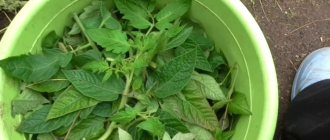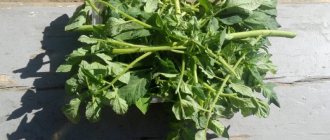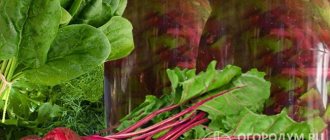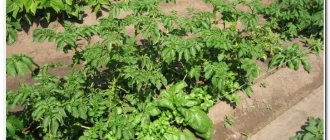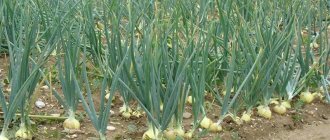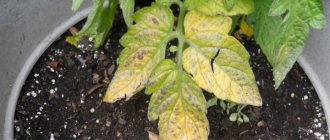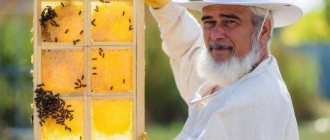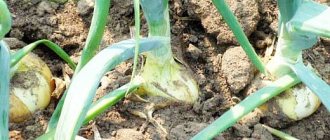Temperature violation
Drought is the enemy of potato plantings. Potatoes prefer temperatures up to + 30 C and high humidity levels. The longer the dry weather lasts, the faster the tops dry from below. If a gardener ignores the problem for a long time, then after a few weeks the yellowness will cover the entire bush. A common misconception is that yellowed foliage will not go away with heavy watering or prolonged rain. Intensive application of moisture will lead to the formation of a crust on the soil surface. It will slow down the rate of moisture penetration to the root system.
On a note!
Regular watering will help prevent potato leaves from turning yellow. During the growing season, the soil moisture level should not be less than 70%. In arid regions, potato tops require additional irrigation. The second recommendation is periodic loosening of the soil. This is necessary during the formation of tubers. Digging increases the amount of oxygen supplied to the root system.
Plant protection
To protect the first shoots from pests and diseases, you need to take care of their protection in advance. To do this you need:
- Plant varieties with immunity to the most common diseases and dangerous insects.
- 15 days after planting the tubers in the soil, treat the area with garlic solution to preserve the green mass. To prepare it, 350 grams of the vegetable are passed through a meat grinder and poured with a liter of heated water. The resulting solution is infused for at least a day, after which it is filtered with gauze. Before using the liquid, another 10 liters of water are added to it to make the solution less concentrated. You need to spray the bushes with garlic mixture three times a month.
- During flowering of bushes, fungicides can be used for prevention. Ditamine, copper oxychloride and Kuproxate are suitable for this.
Not enough nutritious things
The leaves react sensitively to the amount of nutrients introduced. As soon as there are too many or few of them, the previously green tops of the potatoes actively turn yellow. There is a list of symptoms based on which the gardener will determine the defective element.
| Item name | Signs | Troubleshooting |
| Nitrogen | The leaves on the potatoes initially acquire a pale green color. After a few days, the gardener will notice that the tops have turned yellow and fallen off. | Gardeners know that healthy potato bushes need 50 g of nitrogen-containing substances for every 10 kg of root vegetables. Fertilizing is carried out with mineral compounds. They are introduced shortly before planting |
| Phosphorus | With a lack of phosphorus, potato leaves turn yellow ahead of time, and the bushes themselves grow small. The second problem is that even with a slight increase in temperature, planting potatoes quickly dries out. | To prevent yellow and dry leaves from appearing, about 0.9 kg of superphosphate is added to each “hundred square” in the fall. |
| Potassium | It is responsible for the plant’s ability to resist pathogens. If there is not enough potassium, then the young potato bushes quickly turn yellow. The second problem caused by a lack of potassium is associated with a slowdown in photosynthesis | A gardener who adds 1 kg of potassium sulfate for every hundred square meters is sure that the tops of his future potatoes will not turn yellow |
| Iron, manganese | The longer a vegetable lacks iron and manganese, the faster the lower leaves of the potato actively turn yellow. | Young potato bushes are fed with potassium sulfate. For 1 bucket of water take about 5 g of fertilizer. The next step is watering at the root of each bush. Additionally, the leaves are sprayed with a solution of copper sulfate. Take 50 g of the substance per 1 bucket of water. Treatment is carried out every 5 days |
On a note!
Excess fertilizer, as well as shortage, will negatively affect the health of seedlings. Before carrying out the treatment, the gardener assesses the condition of the potatoes, otherwise you will have to puzzle over why the young lower leaves of the potatoes turn yellow.
Potato parasites
Parasites are represented mainly by three types of nematodes:
- Golden.
- Stem.
- Gallovaya.
Golden nematode is very dangerous for potatoes. When infected with this parasite, the amount of harvested crop may drop by half. It mainly affects the root system of the plant. Accordingly, the tops begin to turn yellow and wither, which does not allow tubers to fully form and reduces their number. But visible symptoms may appear only with severe infection. If it manifests itself in a weak form, then it can only be detected by digging up the bush and examining the roots and tubers.
To avoid infection with this parasite, it is better to use varieties that are resistant to it. But every 3-4 years they should be alternated with an unstable variety. This is done to prevent the parasite from adapting. You can also use the cultivation of legumes or corn in this area.
The stem nematode penetrates the tuber from the stem side. After this, the tuber begins to deteriorate - it cracks and rot appears. Accordingly, this fruit has already lost its edible properties and must be thrown away.
The root-knot nematode also settles in tubers, roots and in the underground part of the stem. Plants affected by them stop growing and gradually wither. In the affected areas, thickenings form, which increase and merge with each other. This leads to damage to the protective cover of the root or tuber and the penetration of microorganisms there, after which the affected area begins to rot.
Development of viral diseases
The source of problems will be the neighboring area that is affected by the pathogen, as well as the actions of the gardener. The list of viruses opens with mosaic alfalfa. It will cause the tops to dry out and reduce chlorophyll levels. It is a mistake to believe that the virus can be ignored. Its danger lies in the fact that the tops of future potatoes practically do not turn yellow, but crop losses cannot be avoided. If the problem is left unattended, all plantings on the site will become less resistant to external negative factors. Paying attention to planting material will help prevent such developments. The virus persists in tubers. Before planting them, a detailed inspection is carried out.
Leaf curl virus is another reason why the tops dry out and begin to wilt. The pathogen leads to several negative consequences. The first is a sharp decrease in the volume of the future harvest. The second consequence is the rapid infection of nearby plantings. As soon as the gardener sees that the green tops are withering, he examines the seedlings. Initially, the virus affects only the upper parts of the leaves.
After a few days, the damaged areas seem to “twist” and become rigid. If form II of the leaf curl virus is active in the area, then the lower tops of the potato dry out. There is no effective treatment. The only way out of this situation is to remove the affected plants. As soon as the gardener sees that the lower or upper leaves are turning yellow, the area is inspected for the presence of insect pests.
Can pests cause yellowing?
We recommend reading our other articles
- Wedding decoration. Trends and new trends of 2015
- Invisible window
- Storm
- Syngenta® Tomato Seeds
Not only diseases, but also pests can lead to yellowing of potato tops. The problem is usually clearly expressed - insects can be seen with the naked eye.
In this case, only treating plants with selective or complex action insecticides (Iskra, Antiklesch, Komandor, Confidor Extra, Actellik, Senpai, Inta-Vir, etc.) can help. Selective insecticides should be used if the gardener knows exactly what pest is affecting the plantings.
Development of fungal diseases
Compliance with the rules of watering and fertilizing does not guarantee the gardener the absence of problems. Young potatoes often turn yellow due to the activity of pathogens. More often, a gardener encounters viral diseases:
- Verticillium wilt is a dangerous viral pathology. The pathogen is active at temperatures from + 17 to + 22 C. If you cut the stem, then multiple dark spots immediately catch your eye. As soon as the gardener noticed that the young leaves of the potatoes were turning yellow in June, the affected bush was urgently removed from the site. The second step is preventive treatment of the remaining plantings with a solution of copper oxychloride. It is prepared in a ratio of 50 g of substance per 1 liter of water.
- Fusarium - the gardener sees that first the upper leaves of the potato turn yellow in July, and then the problem affects the lower ones. The starting point in the development of pathology will be excessively high levels of humidity and cool weather. Unfortunately, the leaves of the future potatoes turn yellow and fall off. It is impossible to save the harvest. All affected bushes must be destroyed. Crop rotation is used as a preventative measure. The second rule is that all planting material is subjected to at least two methods of disinfection.
Phytophthora - yellowness first covers the lower leaves. After a few days, the edges of the leaf blade become dotted with dark spots. Once the cause of the problem is determined, fungicides are immediately applied:
- copper oxychloride;
- "Kuproksat";
- "Ditamine."
Why do potato tops turn yellow early?
When growing potatoes, gardeners often notice a change in the color of the tops. If you ignore these changes, you may lose your harvest, so you need to know the reasons for the yellowing of the leaf blade and begin treatment in a timely manner. Leaves often turn yellow due to:
- lack of moisture;
- bright sun;
- lack of nutrition;
- fungal and viral diseases;
- insect pests.
Weather
Often the color of the tops changes due to weather conditions. In hot, dry summers, the lower part of the tops first begins to turn yellow, and over time the entire bush changes color. The optimal temperature for good growth and development is + 25 °C. At high temperatures, the metabolic process of potatoes is disrupted, which leads to a decrease in yield.
Important! Potatoes prefer a temperate climate, high air humidity and average temperatures.
During the growing season, soil moisture levels should be about 70%. When growing potatoes in regions with dry, warm summers, the plantings must be irrigated regularly. Water is especially necessary during the flowering period, since the quality and quantity of root crops depends on it.
Important! During the formation of tubers, it is necessary to carry out regular loosening to enrich the soil with oxygen.
Nutritional deficiencies
Yellowing of the tops can occur due to lack of nutrition. Very often, a potato bush lacks the following microelements:
- Nitrogen - in the initial stage, the foliage acquires a pale olive color, then it turns yellow and falls off. To enrich the soil with nitrogen and enable the bush to grow green mass, it is necessary to fertilize (50 g of urea or any nitrogen-containing fertilizer is diluted in 10 liters of water). Also, to prevent nitrogen starvation, the bed is filled with manure, humus or rotted compost before planting.
- Phosphorus is necessary for the development of the root system and obtaining a generous harvest. If there is a lack of this microelement, potatoes suffer from extreme heat, tubers grow and develop poorly, leaves stretch and turn yellow, and there is a possibility of diseases and pests appearing. To prevent adverse consequences, potatoes are fed with superphosphate.
- Potassium affects the taste and shelf life of the crop. If there is a lack of potassium, photosynthesis is disrupted, the tops turn yellow, and the plant’s immunity decreases. You can help potatoes with potassium sulfate or wood ash.
- Iron and manganese - with a lack of these microelements, the bush acquires a light yellow color, dries out and dies. The situation can be corrected with potassium sulfate (5 g of fertilizer is diluted in 10 liters of water). The prepared solution is poured over potatoes in the morning or evening. You can also apply foliar feeding with a solution of copper sulfate (50 g of the drug per bucket of water). Spraying is carried out every 5 days.
Important! It is better to underfeed potatoes than to overfeed them, since an excess of minerals negatively affects the condition of the tops, the quality and quantity of the harvest.
The problem of nutritional deficiency often occurs due to poor crop rotation. The land is being depleted, resulting in lower productivity. To replenish nutrients, it is necessary to dig up the bed after harvesting, add organic matter and a mineral complex of fertilizers. You can also sow the soil with green manure (mustard and oats). Mustard will enrich the soil with all the necessary microelements, oats will make the soil light and fluffy.
Diseases
Changes in the color of tops often occur due to the addition of fungal, bacterial and viral diseases. Without treatment, the yield decreases, the foliage turns yellow and falls off, and the bush dies.
Verticillium wilt
If the tops of the potatoes have turned yellow and dried out, this may be the first sign of a viral infection. The virus often appears at a temperature of + 17-20 °C. The disease can be recognized by the following signs:
- curling and yellowing of foliage;
- wilting of tops;
- the appearance of dark spots on the cut of the stem.
Verticillium wilt cannot be treated, so potatoes are dug up and burned. For prevention, the tops are sprayed with a solution of copper oxychloride.
Fusarium
If the tops of a potato bush begin to turn yellow from the top, then this is the first sign of fusarium. The disease often appears at high humidity and low air temperature. It is impossible to save the potatoes, so the bushes are dug up and burned. If this is not done, the disease will quickly spread to neighboring plantings and completely destroy the crop. For prevention, it is necessary to observe crop rotation and disinfect planting material.
Late blight
Late blight can be recognized by the yellow tops at the bottom of the bush. In this case, the edges of the leaf blade become covered with dark spots, which, without treatment, grow and spread throughout the plant. To prevent mass infection from occurring, the tops are sprayed with copper oxychloride or the preparation “Kuproksat” or “Ditamine”.
Dry spotting
The disease begins to progress 14 days before flowering. The tops turn yellow, the leaf blade becomes covered with vague brown spots, which quickly grow without treatment. The causative agent of the disease is a fungus, so treatment is carried out with chemicals, such as: Quadris, Oxychom, Ridomil.
Ring rot
The first signs of the disease are yellowing, drying and falling off of young potato leaves. To be sure of the diagnosis, you need to dig up and cut the tuber. Diseased potatoes will have brown or yellow rings in the pulp that encircle the root crop near the skin. Without treatment, the disease progresses quickly, the tubers begin to rot, and when squeezed, mucus will be released abundantly. Treatment consists of removing the affected bushes, and healthy specimens are fed with potassium fertilizers.
Blackleg
If the leaf blade turns yellow near the central vein, then this is the first sign of blackleg infection. But in order to make an accurate diagnosis, it is necessary to dig up a suspicious bush and carefully examine the tubers. In diseased plants they are black, with signs of rot. Diseased bushes are dug up and burned, and the soil is treated with Bordeaux mixture or a mixture of wood ash and copper sulfate powder (4 tbsp. ash and 1 tbsp. powder).
Viral mosaic
The virus spreads in 3 ways:
- through infected instruments;
- when located with an infected plant;
- insects (aphids, cicadas, nematodes).
When infected with a virus, the tops turn yellow, dry out and die, and the tubers become covered with necrotic spots. The disease appears in all regions of Russia, but is most often found in the southern regions. The virus remains active for several years and can overwinter in tubers. Therefore, it is necessary to carefully select seed material. When planting infected potatoes at the beginning of the growing season, small growths appear between the veins, the foliage turns yellow and bends downwards. Sick cells find it difficult to retain moisture, so if there is a lack of water, the bushes quickly die. It is impossible to get rid of the virus, so it is necessary to take preventive measures:
- observe crop rotation;
- before planting, treat the tubers with insecticides and fungicides;
- remove weeds in a timely manner;
- get rid of an infected potato bush.
Pest attack
Potato tops can turn yellow not only from non-compliance with the rules of care and the occurrence of diseases, but also from the invasion of insect pests. To prevent the appearance of insects and grow a rich harvest, it is necessary to carry out preventive measures:
- observe crop rotation;
- carry out timely loosening of the soil and removal of weeds;
- plant marigolds, peas, beets and cabbage next to the potato bed.
Nematode
Nematodes are small worms that live in the soil and attack the root system. Pests suck the juice from the plant, as a result the foliage turns yellow, dries out and falls off. Without treatment, the nematode destroys most of the crop. To combat the pest, marigolds, lupins, rye or oats are planted next to potatoes. Before planting, the soil is filled with urea, 1 kg of fertilizer is used per 1 acre.
Colorado beetle
A common pest that is found in the southern regions. The insect infects potato tops, causing them to turn yellow and dry out. You can get rid of the Colorado potato beetle using the following drugs:
- Spark;
- Bankol;
- Commander.
The drug is diluted strictly according to the instructions, the working solution is used throughout the growing season, until the start of harvesting.
Important! For prevention, marigolds, tansy, calendula or herbs can be planted next to potatoes. The strong smell repels insects.
You can also get rid of the beetle with an infusion of dandelion, celandine or garlic.
Activity of pests and parasites
Viral and fungal diseases are not the only cause for concern. Potato tops often dry out and wither due to the activity of insect pests. Nematode - lives in the ground. The main source of nutrients for it is the juice of the root system. The more actively it eats pests, the faster the potato tops dry out and turn yellow. As soon as a summer resident sees signs of an impending problem, he must immediately take action, otherwise he may lose most of the harvest.
Planting rye, lupine, and marigolds next to potatoes will help prevent negative developments. The second method of prevention is soil treatment before planting tubers. For this, urea is used - 1 kg of the substance for each “hundredth”. Another pest whose activity causes leaves to dry out and fall off is the Colorado potato beetle. You can destroy an uninvited guest by treating crops with special preparations:
- "Spark";
- "Bankol";
- "Commander".
The first treatment is carried out at the beginning of the active phase of the growing season. The final point will be the immediate harvest. The result largely depends on the correctly selected level of solution concentration. As soon as the gardener notices fallen leaves, they immediately take action. Each bush takes up to 70-80 g of the substance, diluted in 1 liter of water. For prevention, it is recommended to plant plants with a pronounced odor near the bush:
- calendula;
- tansy;
- beans.
The Colorado potato beetle cannot tolerate this aroma.
Prevention
May be interesting Potatoes under straw: how to plant and care, cultivation and care How to plant potatoes correctly to get a good harvest? Potato variety Rogneda: description and characteristics, reviews
Experienced gardeners know what to do when potato tops turn yellow. To protect the potato crop from pests and diseases, they try to follow simple but effective rules:
- plant varieties that are resistant to fungal and viral infections;
- to identify tubers infected with late blight, seed potatoes are kept in the sun before planting;
- carry out pre-sowing soil treatment with fungicides, they kill fungal spores and some viruses;
- seed material is sprayed with Maxim, Fitosporin;
- do not take seed potatoes from diseased bushes;
- observe crop rotation.
To prevent parasites (nematodes), lupine and rye are sown around the perimeter of the field, marigolds are planted in the country, and urea (10 g/m²) is added to the soil.
Fungus
Gardeners often wonder why the lower leaves of potatoes turn yellow and then curl. Most likely, this indicates that the plant has been attacked by a viral fungus.
Fungus is a dangerous disease that is quite difficult to defeat. If the virus is at the last stage and has already affected the root system of the plant, then in a few days the entire bush will disappear. Since the disease is viral, it is easily transmitted from bush to bush, so experts recommend that as soon as you see that the base of the plant has turned yellow, it is best to immediately isolate it.
Phytosporosis
This disease is typical for a young seedling; usually the viral cells of the disease live on the inside of the leaf. In the first stages of the disease, dark brown stripes appear. After this, the bush very quickly begins to dry out and wither.
And the plant tubers themselves quickly rot and darken, of course, this significantly affects the percentage of potato yield. In order to save potatoes from such a disease, at the first symptoms it is necessary to spray the bush with special chemicals against such a disease.
Also, in this case, high-quality sorting of the fruit can help. Also, in order to minimize the chances that the disease will spread to potatoes, it is best to plant those types of vegetables around such fruits that are practically not susceptible to such a disease.
Fusarium
First, the lower leaves of the potato turn yellow, then the middle of the leaf and the top. After some time, the entire bush becomes completely yellow. Finding out that a bush is sick is quite difficult, especially in areas where the climate is too dry and hot.
Sometimes such a disease can cause the main column to dry out and it seems that the bush has folded in half, but this is observed quite rarely. Most often, plant seeds are already infected with this virus. Therefore, immediately after it has been planted and the first petals have fallen, you can understand that the bush is infected, since instead of the usual green color they are yellow.
This disease can only be overcome if you immediately take preventive action with the seeds of the bush. In addition, to prevent the disease from manifesting itself and multiplying again, it is best to burn all the stems immediately after harvesting.
The disease appears as long, dark-colored spots on leaves and stems that will increase in size over time. And then the bush dries out completely and dies.
The fruits of the bush are significantly reduced in size. This disease must be dealt with in the same way as photosporosis.
The disease can destroy the crop
This disease occurs due to high humidity and high ambient temperatures. The first symptom is that the stem of the bush begins to turn yellow, but at the same time the upper parts of the bush begin to curl and lose their natural color, and then dry out and disintegrate.
- If you cut the stem of a bush, you can immediately detect rot there; it will resemble a ring, which is where the name comes from - ring rot.
- The big disadvantage of this disease is the fact that rot affects the fruits, and they all disappear in the ground.
- It is very important to check the seeds and carry out disease prevention before planting.
Blackleg
This disease makes itself felt as soon as you planted the first seeds. The lower leaves of potatoes turn yellow as soon as they emerge, and then the entire bush and its root system begin to rot.
To prevent this from happening, all tubers that have been selected for planting must be treated with a fungicide and left to dry for several days, only after which they can be planted in the ground.
Temperature, humidity and watering
When the air temperature rises to +300C, and there is practically no watering, the potato bush gradually acquires a yellow color. In order for potatoes to develop normally and have the standard green color of the tops, moderate humidity is needed, within 70%, and the temperature is maintained at the optimal level of +25..+270C.
Important! Failure to follow the rules for caring for potato plantings leads to a significant reduction in yield. Potatoes with insufficient watering bake in hot soil and cannot be eaten.
To eliminate the yellowness of the tops, it is necessary to loosen the upper layers of the soil well when adding nutrient moisture. This is necessary so that moisture is absorbed into the soil and makes it possible to safely survive the increased temperature.
Useful tips
To successfully grow potatoes, use these effective tips:
- before planting potatoes, it is necessary to pre-fertilize the bed with a mixture of chicken droppings and manure with the addition of soil;
- treat the area with a solution of chicken manure and water. It is necessary to add at least 10 liters of solution per 1 square meter;
- use urea with fertilizers before planting potatoes in the ground. For every 100 square meters of garden you need at least 800 g of solution.
Without exception, every owner who grows potatoes encounters the problem of yellowed leaves. The main thing is to correctly determine the cause of yellowness and take the necessary measures in time.
